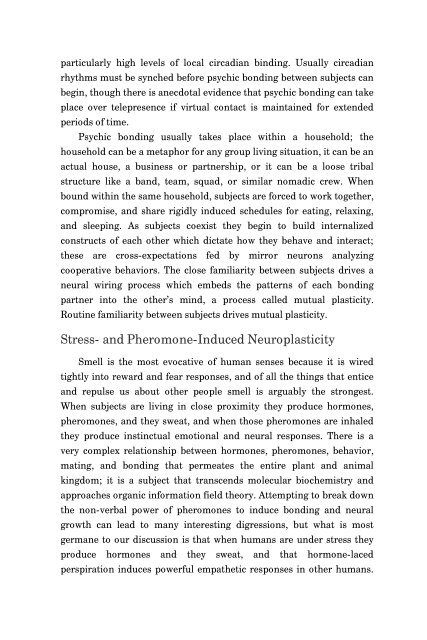Psychedelic-information-theory-Shamanism-in-the-age-of-Reason
Psychedelic-information-theory-Shamanism-in-the-age-of-Reason
Psychedelic-information-theory-Shamanism-in-the-age-of-Reason
- No tags were found...
You also want an ePaper? Increase the reach of your titles
YUMPU automatically turns print PDFs into web optimized ePapers that Google loves.
particularly high levels <strong>of</strong> local circadian b<strong>in</strong>d<strong>in</strong>g. Usually circadianrhythms must be synched before psychic bond<strong>in</strong>g between subjects canbeg<strong>in</strong>, though <strong>the</strong>re is anecdotal evidence that psychic bond<strong>in</strong>g can takeplace over telepresence if virtual contact is ma<strong>in</strong>ta<strong>in</strong>ed for extendedperiods <strong>of</strong> time.Psychic bond<strong>in</strong>g usually takes place with<strong>in</strong> a household; <strong>the</strong>household can be a metaphor for any group liv<strong>in</strong>g situation, it can be anactual house, a bus<strong>in</strong>ess or partnership, or it can be a loose tribalstructure like a band, team, squad, or similar nomadic crew. Whenbound with<strong>in</strong> <strong>the</strong> same household, subjects are forced to work toge<strong>the</strong>r,compromise, and share rigidly <strong>in</strong>duced schedules for eat<strong>in</strong>g, relax<strong>in</strong>g,and sleep<strong>in</strong>g. As subjects coexist <strong>the</strong>y beg<strong>in</strong> to build <strong>in</strong>ternalizedconstructs <strong>of</strong> each o<strong>the</strong>r which dictate how <strong>the</strong>y behave and <strong>in</strong>teract;<strong>the</strong>se are cross-expectations fed by mirror neurons analyz<strong>in</strong>gcooperative behaviors. The close familiarity between subjects drives aneural wir<strong>in</strong>g process which embeds <strong>the</strong> patterns <strong>of</strong> each bond<strong>in</strong>gpartner <strong>in</strong>to <strong>the</strong> o<strong>the</strong>r’s m<strong>in</strong>d, a process called mutual plasticity.Rout<strong>in</strong>e familiarity between subjects drives mutual plasticity.Stress- and Pheromone-Induced NeuroplasticitySmell is <strong>the</strong> most evocative <strong>of</strong> human senses because it is wiredtightly <strong>in</strong>to reward and fear responses, and <strong>of</strong> all <strong>the</strong> th<strong>in</strong>gs that enticeand repulse us about o<strong>the</strong>r people smell is arguably <strong>the</strong> strongest.When subjects are liv<strong>in</strong>g <strong>in</strong> close proximity <strong>the</strong>y produce hormones,pheromones, and <strong>the</strong>y sweat, and when those pheromones are <strong>in</strong>haled<strong>the</strong>y produce <strong>in</strong>st<strong>in</strong>ctual emotional and neural responses. There is avery complex relationship between hormones, pheromones, behavior,mat<strong>in</strong>g, and bond<strong>in</strong>g that permeates <strong>the</strong> entire plant and animalk<strong>in</strong>gdom; it is a subject that transcends molecular biochemistry andapproaches organic <strong><strong>in</strong>formation</strong> field <strong><strong>the</strong>ory</strong>. Attempt<strong>in</strong>g to break down<strong>the</strong> non-verbal power <strong>of</strong> pheromones to <strong>in</strong>duce bond<strong>in</strong>g and neuralgrowth can lead to many <strong>in</strong>terest<strong>in</strong>g digressions, but what is mostgermane to our discussion is that when humans are under stress <strong>the</strong>yproduce hormones and <strong>the</strong>y sweat, and that hormone-lacedperspiration <strong>in</strong>duces powerful empa<strong>the</strong>tic responses <strong>in</strong> o<strong>the</strong>r humans.


